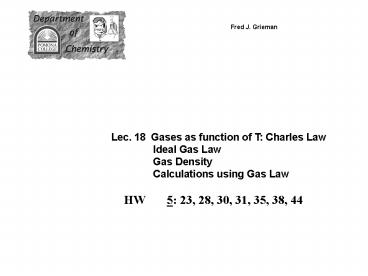Lec' 18 Gases as function of T: Charles Law PowerPoint PPT Presentation
Title: Lec' 18 Gases as function of T: Charles Law
1
Fred J. Grieman
Lec. 18 Gases as function of T Charles Law
Ideal Gas Law Gas
Density Calculations using Gas Law
HW 5 23, 28, 30, 31, 35,
38, 44
2
Gases so far at constant n, T,
______________ (for any gas!) So then P1V1
P2V2 PV f(T) , as T ? , PV ?
e.g., PV ______________________________________
___ PV 30.6 Latm at T 100 ºC, n
1 mol
(P 1atm)
_______
_______
______________
3
Scale?? Used Hg in barometer, maybe use somehow
for T Liquid expands with T ? Measure
expansion assume linear
____________
- t (ºC) c0 (distance) c1
- Why is this bad?
- depends on 1 substance
- (temperature is more fundamental than this)
- limited range for Hg
- linear expansion is an approximation
_____________________
_____________________
_____________________________
________
Vary
Measure
______
P (const.) ?
_____________________
At t 0, V Vo rewrite equation ______________
_
Furthermore a same for all gases
_____________________
Which gas?
__________________
4
- Results from analysis
- New Thermometer _____________ of substance
_____________________ - V Vo a t(oC) Vo solve for t
- ___________________________________________
- Measure V at t 0 oC to get Vo V at t
to be measured - Hg thermometers are calibrated this way!
- 2) Fundamental Measurement of T (Absolute Scale)
- ______________________________ (as a limit)
at lowest temperature possible - _____________________________
- __________________
5
3) T (K) 273.15 (V / Vo) so Vgas
(Vo / 273.15) T so
Avagadro Boyle Charles
_____________________
_______________
_________________
______________________________________
____________________________________________
6
______________________________________
Gas at 373 K
_________________________________________
density
______________________________________
g mL-1
compare to density of water
7
(No Transcript)
PowerShow.com is a leading presentation sharing website. It has millions of presentations already uploaded and available with 1,000s more being uploaded by its users every day. Whatever your area of interest, here you’ll be able to find and view presentations you’ll love and possibly download. And, best of all, it is completely free and easy to use.
You might even have a presentation you’d like to share with others. If so, just upload it to PowerShow.com. We’ll convert it to an HTML5 slideshow that includes all the media types you’ve already added: audio, video, music, pictures, animations and transition effects. Then you can share it with your target audience as well as PowerShow.com’s millions of monthly visitors. And, again, it’s all free.
About the Developers
PowerShow.com is brought to you by CrystalGraphics, the award-winning developer and market-leading publisher of rich-media enhancement products for presentations. Our product offerings include millions of PowerPoint templates, diagrams, animated 3D characters and more.

